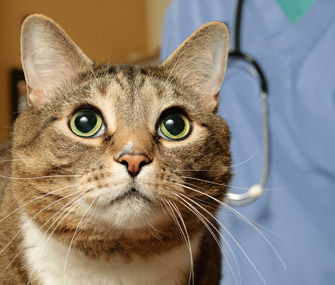Why I Don’t Always Treat the Crystals in Your Pet’s Urine
Published on January 26, 2016
Skip To

The presence of crystals in a urine sample simply indicates the urine is over-saturated with the crystal-forming substance. Mineral substances like calcium and phosphate are common components of urine crystals. Certain "birth defects" such as metabolic disorders and liver blood vessel problems known as portosystemic shunts cause crystals in the urine. One of the most deadly pet poisons, antifreeze, causes crystals in the urine as well, which can provide veterinarians with a vital clue to the diagnosis. Crystals can also occur in both healthy and sick cats and dogs. Formation of crystals depends not only on the substances found in the urine but on your pet’s diet, urine temperature, the acidity of the urine and other complicated factors.
While the presence of crystals in a routine urinalysis can be very concerning to pet families, in light of the above, do all crystals deserve treatment? Is there always cause for alarm? Here are my answers to these questions based on what I do in practice.
When The Answer Is Yes
One of my patients spent last winter in California. While he was there, he ate a bunch of garbage and ended up in the emergency room. An x-ray of his abdomen did not find an intestinal obstruction but did find some bladder stones. When the veterinarian in California called me, the first thing I asked for were the results of the urinalysis. If the laboratory identified crystals in the urine, I could surmise they likely had the same mineral composition as the stones and I could use the presence of the crystals to guide management of his bladder stones (although in some cases a battery of diagnostic tests is needed to determine the proper treatment).When The Answer Is No
Urinalysis is part of my standard wellness laboratory panel for annual examinations in both cats and dogs. Any veterinarian who submits multiple urine samples per day will identify pets with urine crystals but without any clinical signs of urinary tract disease. These pets do not need any type of intervention — dietary or drug therapy to treat the crystals other than continued monitoring to make sure a problem does not develop. Crystals without infection and in the absence of stones or any other clinical signs of disease are not considered to be a medical problem. Crystal formation is in part dependent on the pH of the urine, which in turn is dependent on your pet’s diet and when she last ate. The temperature of the urine also influences crystal formation. Cold urine has more crystals. The presence of a few crystals in the urine does not always indicate an increased risk of developing bladder stones.When The Answer Is Maybe Yes, Maybe No
Extrapolating out from the above scenario, I might treat a cat with crystals in his urine if he is showing any signs of a complicated and consequently poorly defined condition known as feline lower urinary tract disease (FLUTD). In this strange disorder, cats exhibit clinical signs related predominately to the urinary tract, such as frequent trips to the litterbox, straining to urinate and in some cases, blood in the urine. If I just find crystals in a routine urine sample from a healthy cat, no treatment is needed, although the cat might need to be monitored for the appearance of any clinical signs and I might ask the cat’s family just one more time about any extra trips to the litterbox.Yes. No. Maybe. We can see that the answer to this common question from my clients is about as clear as a urine sample full of crystals! The bottom line, though, is that caring for your favorite fur person requires careful assessment of the entire patient, rather than treating just one aspect of a laboratory test.
More on Vetstreet:





